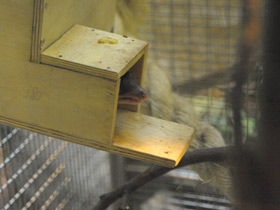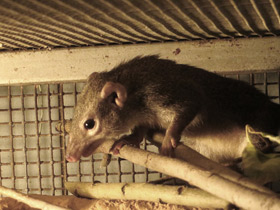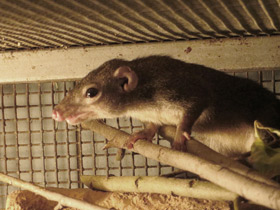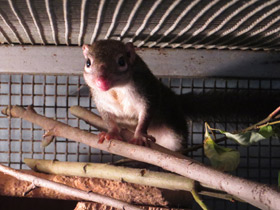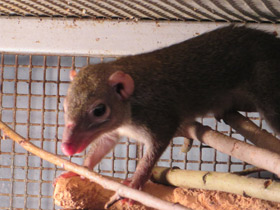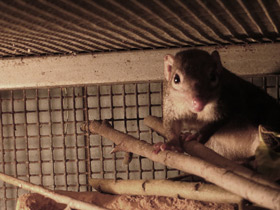The common treeshrew (Tupaia glis)
The common treeshrew (Tupaia glis) is a small mammal in the treeshrew family Tupaiidae, and is native to Thailand, Malaysia, and Indonesia. It has been listed as Least Concern by IUCN as it remains common and displays some adaptability to ongoing habitat loss.
Habitat, description and diet
Tupaia glis inhabits the rainforests of Southeast Asia: the Malacca Peninsula, Thailand and the islands of the Malay Archipelago. This animal has a pointed snout, short sensitive vibrissae, small cartilaginous ears and small eyes. The tupaia's feet are equipped with sharp, long claws, which allow it to climb trees with dexterity. Its diet is based on various fruits, which it collects from trees and among fallen leaves in the forest canopy. Tupaia glis also eat various insects (grasshoppers, crickets, beetles, molluscs) and hunt small vertebrates (frogs, lizards, chicks of small birds). When eating food, they, like squirrels, hold it in their front legs while sitting on their hind legs. Tupaia glis live in permanent pairs, defending the family territory.
Reproduction and social behaviour
Their pregnancy lasts from 40 to 52 days, after which 1 to 3 blind, helpless cubs weighing 10-12 g are born. Tupai's care of their offspring is characterised by unique traits. Thus, the cubs are in a separate nest, which is usually built by the male. The female spends very little time with them, visiting them for only 10-15 minutes every 48 hours (i.e. she spends no more than 1.5 hours with the cubs during the entire period). Each calf has time to suckle 5-15 g of very fatty and nutritious milk per feeding. Their eyes do not open until the 20th day of life, and after 36 days the young go to live in the parental nest. Grown males are expelled from the family territory, while females usually stay with their parents. Already at 4.5 months of life they are able to bring the first offspring. The short pregnancy and rapid maturation of the young ensure a high reproduction rate for tupaia.
Taxonomic status
The species was first described in February 1820 by the French explorers Pierre-Médard Diard and Alfred Duvaucel in their jointly written article "Sur une nouvelle espèce de Sorex — Sorex Glis", which is preceded by an illustration. They observed specimens in Penang and Singapore, and considered them a species of Sorex, and not as a new genus. Between 1821 and 1940, several zoologists described the species from other areas. The species still retains many forms of uncertain rank and validity, and is pending a detailed study. Some forms were formerly considered synonyms of Tupaia glis; some were elevated to species level. Synonyms include:
- ferruginea (Raffles, 1821);
- press (Raffles, 1821;
- hypochrysa (Thomas, 1895);
- chrysomalla (Miller, 1900);
- sordida (Miller, 1900);
- phaeura (Miller, 1902);
- castanea (Miller, 1903);
- pulonis (Miller, 1903);
- tephrura (Miller, 1903);
- demissa (Thomas, 1904);
- discolor (Lyon, 1906);
- batamana (Lyon, 1907);
- siaca (Lyon, 1908);
- lacernata (Thomas and Wroughton, 1909);
- raviana (Lyon, 1911);
- pemangilis (Lyon, 1911);
- wilkinsoni (Robinson and Kloss, 1911);
- penangensis (Robinson and Kloss, 1911);
- longicauda (Kloss, 1911);
- obscura (Kloss, 1911);
- longicanda (Lyon, 1913);
- anambae (Lyon, 1913);
- redacta (Robinson, 1916);
- jacki (Robinson and Kloss, 1918);
- phoeniura (Thomas, 1923);
- siberu (Chasen and Kloss, 1928);
- cognate (Chasen, 1940);
- umbratilis (Chasen, 1940).
Threats
Common treeshrews are threatened due to deforestation and ensuing human activities in agriculture (for example, using trenchers to dig ditches), plantations, and commercial logging. Moreover, other pressures, such as hunting for food and sport, can create pressure to the species.
As a model organism
Tupaia glis is used by researchers as animal models for human diseases because of their close relationship to primates, and their well-developed senses of vision and hearing. Research studies have included hepatitis. Another instance has been documented where an individual of Tupaia glis developed breast cancer.

















